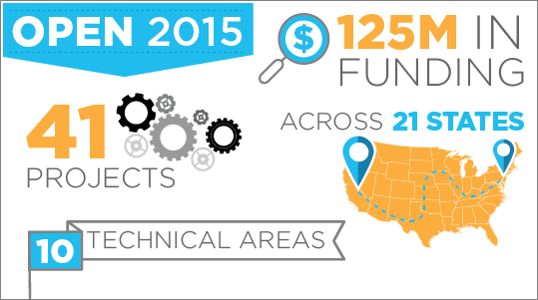ARPA-E, the Energy Department’s blue-sky research program, usually names a specific technology or topic for each of its multiple multimillion-dollar project solicitations -- energy storage, or grid management software, or better solar/wind/tidal/biomass energy generation. But once every three years, it issues an open solicitation for projects in any category -- or potentially, one it hasn’t created yet.
On Monday, ARPA-E handed out $125 million to 41 projects that made the cut for its Open 2015 solicitation. It’s a pretty weird mix, ranging from the prosaic, such as more efficient window glazing, or better knock suppression in Cummins generators, to the esoteric, like San Diego, Calif.-based Marine Bioenergy’s plan to cultivate algae in the open ocean.
On the energy storage front, we’ve got research on lithium-ion, sodium-based and flow battery processes and materials, as well as some promised improvements to storing power through ammonia production and water electrolysis. General Electric and Los Alamos, N.M.-based Tibbar Technologies won awards to work on high-voltage power conversion technologies to help solve transmission grid challenges. And Monday’s list also includes some interesting grid software projects, largely stemming from ongoing work at universities and research labs.
Here’s a short breakdown of the most interesting projects, with commentary.
Energy storage
ARPA-E has been funding energy storage research across multiple technology categories, whether it’s different chemistries, processes, or software to manage it. This week’s energy storage awards are split between two that are working on existing battery chemistries, and two that are trying more unusual electricity-to-chemistry approaches.
Oak Ridge National Laboratory’s $2.8 million project will work on a proton-selective membrane that doesn’t need hydration, like those used in today’s flow batteries or fuel cells, which could lower system component cost and complexity. And Iowa State University’s $2.9 million grant will go toward developing a sodium-based battery that can operate at room temperature, unlike today’s superheated sodium-sulfur (NaS) batteries used for large-scale grid storage.
Electrolysis -- using electricity to split water into hydrogen and oxygen -- has long been hailed as a massive energy storage opportunity, if we’re looking at hydrogen as a fuel source. Boca Raton, Fla.-based Dioxide Materials was awarded $2 million to develop an alkaline water electrolyzer that doesn’t need platinum, which could lower electrolysis system costs tenfold.
Ammonia production, used largely for fertilizer, also consumes a great deal of electricity. Salt Lake City-based Ceramatec, which won $2.4 million, says its technology can cut those energy inputs by more than 20 percent, with a modular system that could allow for distributed production of a product that’s trucked to farms today.
Grid software
ARPA-E has been putting a focus on the software side of grid modernization for several years now, seeing it as an important integration and management tool for a renewable and distributed energy future. This week’s projects include several well-known research organizations that have been working on ARPA-E projects for years, as well as a few newcomers.
Pacific Northwest National Laboratory is a center of the DOE’s grid software research, including a seven-state pilot project that’s collected a ton of data and started to implement some capabilities, focusing on balancing hydropower, wind and solar power with flexible demand. This week, it won $3.1 million to develop a high-performance power grid optimization software suite, dubbed HIPPO, focusing on improving the speed and accuracy of modeling system-level reliability at different levels of intermittent generation.
Another hotbed of DOE grid research is Knoxville, Tenn., which is close to Oak Ridge National Laboratory. A University of Tennessee, Knoxville-led team won $2.4 million this week to work on open source-based microgrid controllers, to make it cheaper and easier to integrate distributed energy resources at the grid edge into distribution grid operations.
Open-source software is also at the heart of Vanderbilt University’s project, funded with $3.5 million from ARPA-E, to develop a standard platform for integration of different grid-facing software systems and devices. Many of the latest generation of smart meters, grid sensors, communications hubs and other edge-of-network devices are coming with Linux cores, which could open them up to far more flexible uses for distributed computing and data collection.
There’s also an interesting project that’s meant to support the emergence of an entity that doesn’t really exist yet, but which regulatory efforts in states like California and New York are pushing to create. That’s the independent distribution system operator (IDSO), a third-party entity that manages the interplay of centralized and distributed energy resources across the low-voltage power grid. Atlanta-based ProsumerGrid won $3 million to develop a software modeling platform to “enable the development of distributed energy resources scheduling logic, market rules, and energy service transactions,” with an eye on using it to help regulators test out different structures for their distribution system operators.




